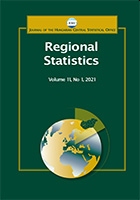The importance of aggregation in regional household income estimates:
A case study from Hungary, 2019
Tibor Bareith – Adrián Csizmadia
Regional Statistics, Vol. 13. No. 6. 2023
Do the results of analyses with spatial data depend on the level of aggregation?
The literature refers to the problem of spatial aggregation as the „modifiable areal unit
problem” (MAUP). The main research question is whether spatial analysis using different estimation techniques (OLS, SEM, SAR, SDM) is affected by the MAUP problem. Our spatial analysis focuses on household incomes. For Hungary, spatial data are available at the municipal, district and county levels to explore the problem, and income inequality is average at the European level. The results suggest that the MAUP problem exists in Hungary. Increasing the aggregation significantly reduces the proportion of significant explanatory variables for all models. This implies that spatial analyses should be performed at the smallest possible spatial scale to obtain the most accurate model estimates. The spatial autocorrelation of the income indicator is also affected by aggregation: there is no difference in the global autocorrelation between the municipal and district level, but the global indicator is much lower at the county level. The degree of local autocorrelation decreases significantly with the level of aggregation.
Another finding is that household incomes are mainly influenced by the working-age
population, the presence of entrepreneurs, the number of jobseekers and schooling,
while occupational classification also has a significant impact on incomes.
Keywords: income, aggregation, MAUP, spatial models, spatial autocorrelation



